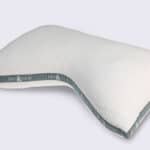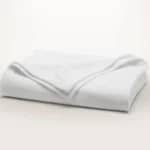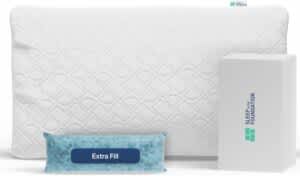Choosing the right pillow can make a significant difference in how well you sleep and how likely you are to wake up free of any aches and pains. The purpose of a pillow is to support your head, neck, and shoulders so that they stay comfortably aligned with your spine.
Extensive research has shown that different pillow types and materials offer a range of support and comfort, depending on an individual’s sleep needs. We discuss what factors to consider when choosing a pillow and how to test a pillow to know if it’s right for you.
What’s the Perfect Pillow for You?
The perfect pillow for you depends on your individual needs and preferences, including the position in which you sleep. In other words, your sleep position determines what kind of support you need in a pillow.
Spinal alignment is a key component of good posture and overall health. A good pillow does its job by keeping your head, neck, and spine in the ideal alignment. This helps to prevent neck pain and decreases the amount of pressure on your body.
There are several factors to consider when selecting a pillow, including the size, shape, and materials. But ultimately the goal is to find a pillow that makes you feel comfortable and helps you achieve a restful sleep.
Our Top Pick for Foam Pillows

Sleep Is the Foundation Shredded Memory Foam Pillow
The Sleep Is the Foundation Shredded Memory Foam Pillow contains cushy adaptive fill that cradles the head and neck. You can add or remove the foam to optimize the loft based on your sleep position and personal preferences.
Why Is the Right Pillow Important?
A pillow is designed to support the head, neck, and shoulders so that the spine can stay aligned during sleep. The position of your spine influences your posture, an important part of overall health. Sleeping on a pillow that doesn’t provide adequate support can lead to a variety of problems, including neck pain and poor sleep quality.
The right pillow can help you get a better night’s sleep. The quality of your sleep can impact almost all aspects of your health, from helping your immune system to improving your mood. Bedding, especially your pillow, is a key element in creating an ideal sleeping environment that can help your body maintain good posture and ensure consistently good sleep.
Shop the Best PillowsWhat Is the Best Pillow Based on Sleeping Position?
When you choose a pillow, you should consider your sleeping position. Whether you sleep on your back, side, or stomach will affect the position of your spine and how much support your head and neck will need while you rest. You can select or adjust a pillow’s size, height, and firmness to accommodate the position you usually sleep in.
Back Sleeper
If you are a back sleeper, it is important to find a pillow that will support the natural curve of your neck. One option is a cervical pillow that is higher in the bottom third and slopes down in the center where your head lies. A standard pillow that is medium to thin in height may also offer enough support for your head without changing the angle of your neck.
Back sleepers also need a pillow with a medium firmness that allows the head to be aligned with the spine. It also prevents the pillow from becoming too flat while you sleep. Consider a memory foam pillow as this type will shape itself around your head and neck.
Side Sleeper
Most people are side sleepers, sleeping in a fetal position or straight on their side. Side sleepers require a larger amount of support from their pillow, both in height and level of firmness.
It is recommended that side sleepers use a pillow that offers about 4 to 6 inches of height, which can help keep the nose aligned with the sternum, filling the space between the ear and the outer shoulder. This position prevents neck strain and helps you maintain a proper posture during sleep. Body pillows may also be a good option for side sleepers, as they can support the pelvis and hips.
Selecting a moderate to heavy firmness can also be beneficial for side sleepers. Fill materials like buckwheat hulls, memory foam, and latex tend to be firmer, while down pillows are usually softer unless densely packed.
Stomach Sleeper
People who sleep on their stomach may need to consider what parts of their body need support in order to maintain good spinal alignment while they sleep. A stomach sleeping position can put stress on the spine or the muscles of the back and shoulders. In some cases, experts advise people with back pain against sleeping on their stomach.
But if you feel most comfortable sleeping on your stomach, a pillow for stomach sleepers that is softer with a lower height may work best for you. Down and feather fill tends to be less firm than other materials and may be compressed to a comfortable height.
If you sleep half on your stomach and half on your side, or if you sleep with your arms under your torso, you may want to try a body pillow for extra support. Positioning yourself around a body pillow may give you a similar feeling to sleeping on your stomach, but allows you to arrange your head and neck so that they can comfortably align with your shoulders and hips.
Other Elements in Pillow Choice
Design elements like shape, size, and material contribute to how much or how little support a pillow can offer. Depending on the position you usually sleep in, you may want to think about how each of these factors will affect your posture and overall comfort.
The goal is to find a pillow that offers the right amount of support and helps keep your body at a comfortable temperature so that you can wake up feeling well rested.
Pillow Shape
The typical pillow is shaped like a rectangle and comes in several sizes that correlate with the width of twin, queen, or king size mattresses. Other common shapes include cervical or neck pillows that have rounded corners contoured to fit the head and neck and longer body pillows that can provide support from the head down past the hips.
Pillow Size
Pillow size refers to how much space the pillow takes up when it is flat on the bed, while loft refers to how high or thick the pillow is. Pillow loft has a direct effect on how much support is provided to the head and neck and is an important factor when trying to prevent or relieve neck or back pain.
Pillow Fill
Material selection may be one of the most important factors to consider when choosing a pillow. The type of material a pillow is filled with will determine its loft and firmness, which is useful to know when deciding how much support your neck and shoulders may need.
Different materials can influence how well the body regulates temperature during sleep. A lower body temperature tends to correlate with better quality sleep. Pillows made of fill materials and pillowcases that are breathable can lower a sleeper’s body temperature and reduce the likelihood of sweating during sleep.
People who have allergies or who are sensitive to certain materials should also pay special attention to what is in their pillows. Pillow protectors can also be purchased to help minimize contact with potential allergens like dust mites.
Pillows can be filled with a wide variety of materials. Some are more commonly available than others.
- Down: Down fill comes from the undercoat of a duck or goose. Down is an extremely soft material that can quickly flatten. So while it may offer a low loft profile for those that don’t need very much support, a down pillow may need to be frequently fluffed up to feel comfortable.
- Feathers: Feathers also come from birds but are the outer covering of a bird rather than the undercoat. They are flatter than down and include the quill. Feather pillows are firmer than down pillows, and may hold less heat.
- Memory foam: Memory foam pillows can be constructed with a solid piece of foam or with bits of memory foam inside the pillow. It can be designed to cradle the head or shift to accommodate a person’s movement while they sleep. Memory foam can be denser and less breathable than other materials, which may make it harder to stay cool.
- Polyester: Polyester pillow fill looks similar to cotton. It’s the most common type of pillow fill, and it’s also the least expensive. However, dust mites like to live in synthetic pillow fills such as polyester, so people who have certain allergies may want to avoid this material.
- Latex: Latex can be synthetic or a natural material created from tree sap. Like memory foam, it may come as a solid piece or cut into many small pieces. Latex pillows can be heavier and firmer, and latex quickly returns back to its original shape after you press it.
- Buckwheat: Buckwheat pillow fill is made of dry seeds. This filler tends to be very firm and can shape itself around the head and neck. Buckwheat also tends to be better for maintaining a cool body temperature.
Our Top Pick for Latex Pillows

Saatva Latex Pillow
The Saatva Latex Pillow contains plush latex and fiber fill for optimal cushioning and neck support. You can remove the insert for lower loft if you’re a stomach sleeper.
When to Replace Your Pillow
No matter what kind of pillow you choose, it won’t last forever. You should get a new pillow every two years. A high quality memory foam pillow may last about three years.
You can tell if you need a new pillow by closely examining it and checking for signs of aging, including:
- Stains
- Odors
- Physical wear and tear
- Loss of shape
If you notice your pillow has any of these signs, it’s time to replace it. Keeping a pillow for too long isn’t a good idea. Mold, dead skin cells, and dust mites populate in old pillows that need to be thrown out.
Shopping for a New Pillow
You can shop for pillows online or at in-person retailers. While shopping for pillows online limits your ability to examine the pillow for firmness and texture, reading detailed descriptions and understanding the construction can help you select the best pillow.
If you shop for a new pillow at a brick-and-mortar store, there are some steps you can take to find one that suits your needs.
- Test the firmness of the pillow: Place the pillow on a flat surface. Press it with your palm until it’s half its original thickness. A firm pillow will require more pressure than a soft pillow. A pillow’s firmness will tell you how much support it may offer your head and neck.
- Fluff the pillow: If a pillow is made of small pieces of material inside of it instead of a single solid piece, it can lose its shape. To test it out, fluff the pillow to see if it returns to its original shape. A pillow with an even shape and fill is generally considered more comfortable for sleep.
- Examine the outside cover: Choose a pillow that is sewn together well. This will reduce wear and tear and help the pillow last longer.



































